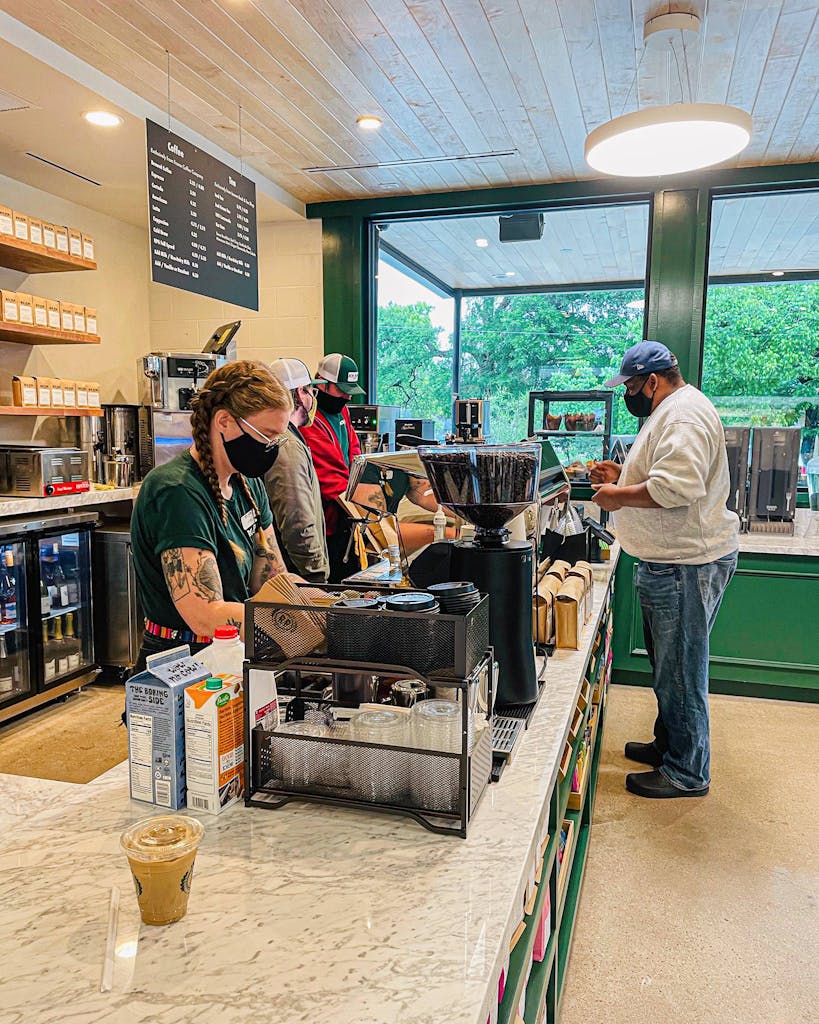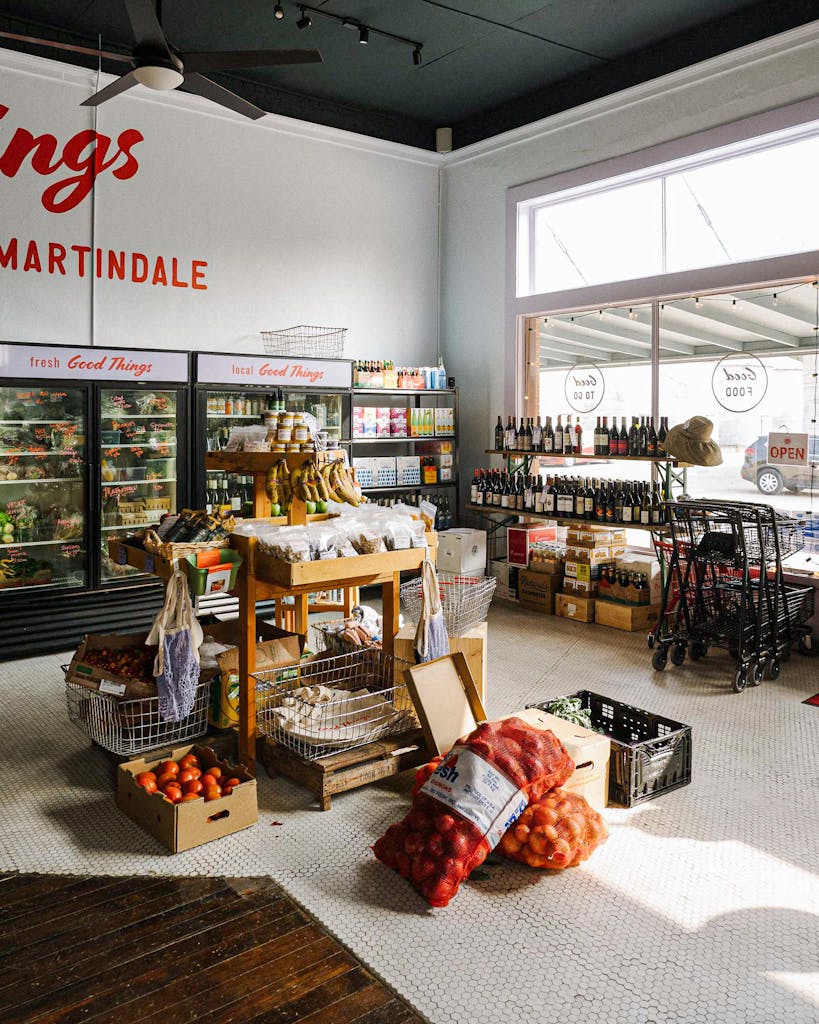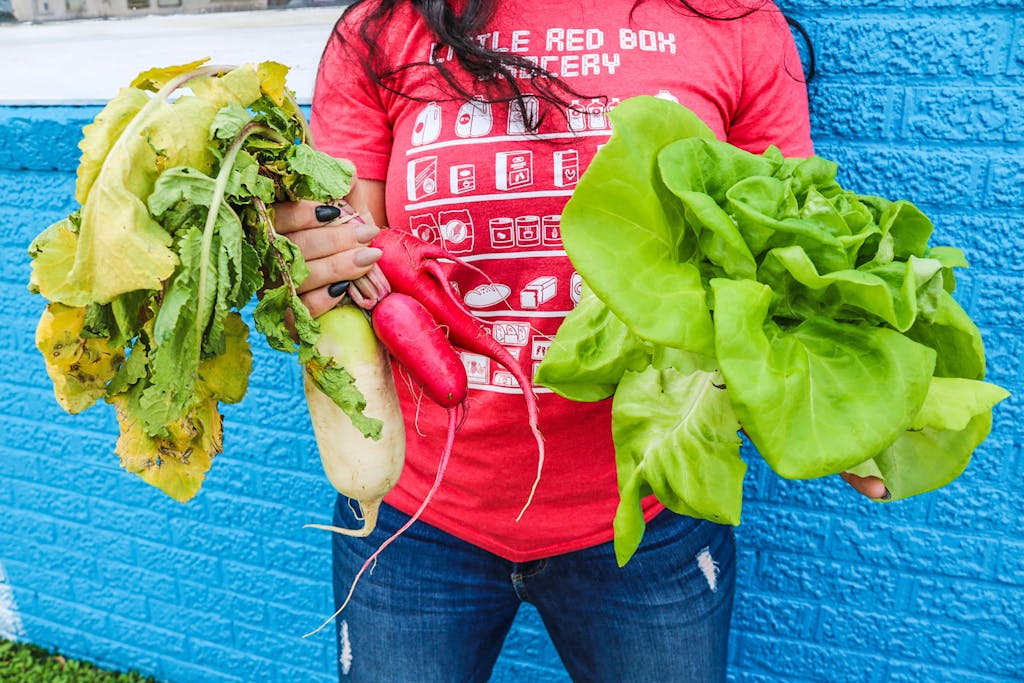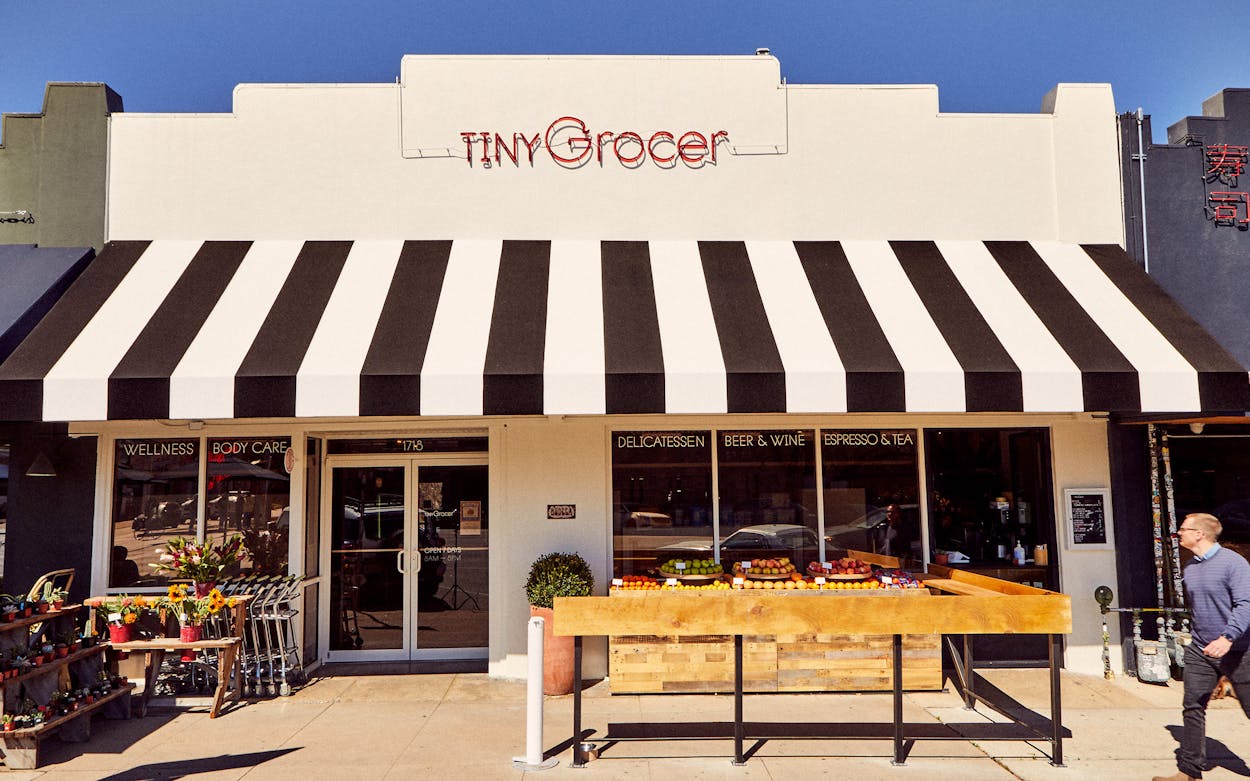Austin and Taylor Burge opened Chaparral Coffee on Lockhart’s town square five years ago, but the couple ended up serving their community more than just the best coffee in town. When the COVID-19 pandemic unfolded in 2020, they began carrying staples like bread, milk, eggs, and deli meats. As the tiny space morphed into a makeshift bodega, Taylor sent out a survey to the customers on their email list, inquiring about shopping habits and desired products.
When they received more than three hundred detailed responses, they knew it was time to seek out a space to open a grocery store. The Burges opened Good Things Grocery in Martindale, ten miles west of Lockhart, in September 2020. It became one of a handful of mom-and-pop operations across Texas that pivoted to provide essentials when lines at major grocery stores were hours long and aisles completely wiped out.
The chaos of the last two years reenforced the fact that independent grocers are on the rise as customers seek a closer connection with community and food.
“During the ice-pocalypse, we had lines around the block, so that’s how our sales got going,” says Noa Sutherland, who opened Zoi Market in Buda with her husband Travis, the founder of UtopiaFest. Though there’s an H-E-B just a few miles away, the Sutherlands don’t consider their business a competitor.
“Smaller grocers have to specialize—at least we do,” Noa says. “We specifically work to carry foods that are not readily available at our local and bigger grocers.” Zoi Market’s stock is built around the food inflammation testing Noa does at her nearby herbal medicine and acupuncture clinic, with plenty of organic, gluten-free, vegan, and dairy-free options. The Sutherlands opened a second location in rural Utopia, and they moved the Buda flagship down the street to a historic 7,700-square-foot mercantile building. The shop now houses an herbal pharmacy, a natural market, and a cafe. “The world doesn’t need more Zoi Markets,” she says, when asked about future expansion plans. “It needs more people to open neighborhood groceries that really care about local health and wellness and needs.”
Beloved Texas grocery chain H-E-B, known for its participation in disaster relief across the state, has been heralded for its adaptability and preparedness during the pandemic, but it still grappled with supply and demand.
“H-E-B and Whole Foods are two of the smartest and most successful retail grocers in the world, and even they struggled to keep basic products on the shelf at the height of this,” says Ben Runkle, who opened Austin’s Salt & Time in 2010. Runkle turned his butcher shop and restaurant (which already had a small grocery component) into a full-fledged market selling high-quality, chef-approved ingredients like Rancho Gordo heirloom beans and Jacobsen sea salt.
With Runkle’s curated selection of goods, plus the perceived safety of a small-scale shopping experience, sales flourished. The changes also gave him a head start on the retail space he’s planning to open in Austin’s St. Elmo Public Market.

The Food Industry Association’s May 2020 U.S. Grocery Shopper Trends report found that 49 percent of consumers are cooking or preparing their own meals more now than before the pandemic, and 42 percent say they “love” to shop for groceries. But hospitality and grocery veteran Steph Steele says the reality is more complicated. “I don’t think the role of grocery stores has changed; I think the perception has changed,” says Steele, who opened Tiny Grocer on Austin’s South Congress Avenue in March after 24 years of running store locations for Whole Foods. “I think the regular individual now sees grocery a little differently.”
Her 1,730-square-foot shop carries some staples you’d find in a larger grocery store, plus made-to-order breakfasts and sandwiches, small-production wine and beer, apothecary items, gift-worthy housewares, and specialty pantry items like cherry blossom shoyu and local pecan butter.
In May 2021, restaurateur Lou Lambert revived Roy Pope Grocery, a Fort Worth store that first opened in 1943. With the reboot comes a new coffee shop and wine bar, a dog-friendly patio, frozen custard, a floral department, and shelves full of high-end culinary products. But the footprint of the historic store remains the same: original butcher cases, beautifully refurbished freezers and refrigerators, and a custom butcher counter now serving chef-created prepared foods. “We learned during COVID that people are changing ways they spend their food dollars,” Lambert says. “They’re cooking more, getting takeaway meals more, and paying more attention to the quality of foods they’re buying.”

Entrenched in Community
These small grocers play an important role beyond providing provisions—they act as gathering places.
“When I lived in New York and San Francisco, I was fascinated with neighborhood grocery stores because of the community they create and foster,” Lambert says. “I loved seeing neighbors there, and I could find everything I needed to make dinner that night. It’s a civilized way to live your life, and it creates identity in the neighborhood.”
Software designer Samuel Stavinoha decided to revive a historic grocery store called the French Company Grocer in Marathon in 2019. Stavinoha had been coming to West Texas for years to rock-climb and run trails when a lengthy conversation with the store’s owner inspired him to take over. He was just getting his bearings and learning how to operate a grocery store when the coronavirus pandemic hit.
Since tourism affects the economy of the town of around four hundred, business took a big hit when Big Bend National Park closed for a period of time in spring 2020, and Stavinoha says many locals started ordering essentials online from megastores, to be delivered straight to their doors. He decided to start diversifying, first building a coffee bar inside before turning the backyard into a beer garden and music venue, a change that breathed new life into the space.
“We’re constantly adapting to the needs of the area and there’s quite literally nothing we don’t do,” Stavinoha says. “We’ve sold metal and lumber and ponchos and apparel and turkey sandwiches and custom cakes, and served brunch and thrown a music event at night—all in the same day. It’s a rendezvous point, it’s a tourist info center. It’s really a community hub.”

Investing in Local
Many of the small grocers that opened during the pandemic also chose to invest in their local communities by carrying locally grown, raised, and crafted products.
“My big thing is just wanting the people who make this stuff to be paid a livable wage and to create opportunities for people to do more,” says Taylor Burge, of Good Things Grocery in Martindale. “If the pandemic taught us nothing else, it’s that we have to support one another on a hyper-local basis.” Good Things sends email updates detailing its offerings from family operations like Texas Farm Patch in Pleasanton, Gundermann Acres in Wharton County, and Emadi Acres Farm in Lockhart.
When Central Texas iced over just two months after Zoi Market opened, Travis Sutherland drove to different farms and ranches to pick up meats, vegetables, eggs, and cheese. Runkle sources from a variety of local farms through the distributor Farm to Table, and he has cultivated an important relationship with Manor’s Steelbow Farm, which will grow things on request for Salt & Time. And he has helped support his peers during the pandemic by carrying local items like Bufalina pizza dough, Nixta tortillas, L’Oca d’Oro pasta, and LeRoy and Lewis beet barbecue sauce.
Matti Bills grew a similarly community-focused model with Three Six General in San Marcos. Bills began butchering and smoking barbecue, bacon, and sausage to sell at Austin-area farmers’ markets while she was pursuing an environmental science degree at St. Edward’s University. In November 2019, she launched Three Six General and business was booming—until the pandemic hit and farmers’ markets began shutting down. She sought kitchen space to expand her wholesale operations and landed a retail butcher shop where she features Texas products like HeartBrand Wagyu beef, 44 Farms black Angus, and Peaceful Pork whole hogs.
She also found herself with enough space to open a general store selling food made in-house from the meat trimmings (sauces, chilis, soups), plus goods made by her farmers’ market colleagues Barton Springs Mill, the Sourdough Project, SRSLY Chocolate, Two Hives Honey, and Casper Fermentables. Her continued success has allowed her to expand into a full-fledged grocery store, with fresh produce, dairy items, and pantry essentials.
“We didn’t know it at the time, but San Marcos needed this so badly,” Bills says. “We were afraid people would perceive us as ‘yuppie,’ but really we’re all about the local food and we want it to be affordable and available to people. Inevitably, local food is a little bit more expensive.”

Supplying a Small Grocery
While local products are expected to come with a higher price tag, it’s a challenge for small grocers to offer even basic products at a reasonable rate, thanks to a system that favors large grocery chains that order more. Noa Sutherland says that when they first opened Zoi Market it was cheaper to purchase directly from H-E-B and resell items than to order from a supplier.
“The more you order on the regular, you get put into a better bracket,” explains Taylor Burge, who opened a second location of Good Things Grocery in downtown Lockhart in December.
Though she imagined another store would allow her to offer lower prices, COVID-related supply chain issues have presented even more challenges. For example, many imported products have gone up in price, and milk has too, because of an increase in the cost of its containers. Because the price of grain has also increased, local grass-fed beef is now cheaper than meat carried in big-box grocery stores.
Randy and Cyndi Johnson’s independent grocery, The Market in Flatonia, moves even more product than the other small groceries mentioned here, so they are able to set prices a bit more competitively. The couple came out of retirement in April 2018 to open their store in the agricultural town located midway between Houston and San Antonio.
“I do not agree with the philosophy that because we are in a small community people should have to pay premium prices,” Cyndi says. “I will never reach the level of H-E-B or some of the other stores because I only have one store and my volume could never be as large. We work very hard to come within a competitive price. That means we make less per sale, but our overhead is under control, so I am able to do this and keep growing.”
It’s no wonder then that customers come from beyond Fayette County to shop at the nearly 4,000-square-foot store. During the initial period of pandemic, the Johnsons delivered groceries to people’s homes, kept the shop open early and late, and even had to stand their ground when distributors tried to redirect their stock to bigger stores.

Marrying Accessibility and Affordability
The U.S. Department of Agriculture defines a food desert as an area with no access to a store with fresh and nutritious food options within one mile, for urban areas, or within ten or more miles in rural ones. In 2015, 39.4 million Americans—or 12.8 percent—lived in low-income, low-access areas. Making fresh, healthy food accessible is exactly what some mom-and-pop grocers are poised to do.
Samuel Newman founded Little Red Box Grocery in June 2019 to eradicate food deserts in the Galveston and Houston areas, using a curbside model to sell a variety of pantry items plus meal kits, produce, baked goods, frozen foods, dairy, meat, and seafood.
“On the one hand, you have big-box grocery, which isn’t designed to make money in small-format stores with a predominantly low-income consumer base, and on the other hand, more prevalent convenience stores provide little in the form of healthy, fresh, and affordable options,” Newman says. “Accepting this as static, the problem will continue in the direction from bad to worse.”
A partnership with a local nonprofit allows Little Red Box to leverage grant funds to make a pay-what-you-can program possible. It also accepts SNAP, as do The Market and Good Things Grocery. Just this fall, Newman closed his Galveston location to focus on building his first full-fledged permanent location, slated to open this spring in Houston’s Second Ward.
“Not only will having our doors open most hours of the day, most days of the week put us physically amongst our neighbors, but it will also provide us the opportunity to serve in ways beyond selling good food,” Newman says. He lists cooking classes, nutrition education, voter registration drives, and SNAP/WIC sign-ups as some of the things he plans to offer in his store.
Customer Service Reimagined
Though these mom-and-pops might not be able to price their wares as low as high-volume grocers can, customers are paying for more than just a product.
“I want that old model of a general store, where you can get your bulk goods, you can get your farm fresh veggies, you can get your local meats, and have a relationship with your people,” says Burge, whose customers sometimes run a tab and pay at the end of the week.
All of the proprietors speak about filling special requests for their customers whenever possible.
“We’re not a normal grocery store—we walk around, we give out recipes, we talk to our customers, we make friends, they invest in us, we invest in them,” says Cyndi Johnson of The Market.
She not only knows her customers by name, she replies to their questions all day long via text, and knows when their houses are under construction and their family members are sick.
“I think people appreciate this size of a grocery more now,” Johnson says. “They found out what customer service was again, and they found out we’re not just here for the dollars. We’re here for the community, and I think that’s true of most small, independent grocers.”






